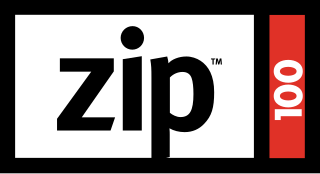
The Zip drive is a removable floppy disk storage system that was announced by Iomega in 1994 and began shipping in March 1995. Considered medium-to-high-capacity at the time of its release, Zip disks were originally launched with capacities of 100 MB, then 250 MB, and finally 750 MB.
A music workstation is an electronic musical instrument providing the facilities of:

A sampler is an electronic musical instrument that records and plays back samples. Samples may comprise elements such as rhythm, melody, speech, sound effects or longer portions of music.

Floptical refers to a type of floppy disk drive that combines magnetic and optical technologies to store data on media similar to standard 3+1⁄2-inch floppy disks. The name is a portmanteau of the words "floppy" and "optical". It refers specifically to one brand of drive and disk system, but is also used more generically to refer to any system using similar techniques.
The Ensoniq Mirage is one of the earliest affordable sampler-synths, introduced in 1984 as Ensoniq's first product. Introduced at a list price of $1,695 with features previously only found on more expensive samplers like the Fairlight CMI, the Mirage sold nearly 8,000 units in its first year - more than the combined unit sales of all other samplers at that time. The Mirage sold over 30,000 units during its availability.
Ensoniq Corp. was an American electronics manufacturer, best known throughout the mid-1980s and 1990s for its musical instruments, principally samplers and synthesizers.
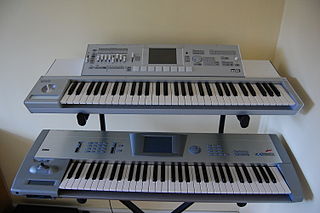
The Korg Triton is a music workstation synthesizer, featuring digital sampling and sequencing, released in 1999. It uses Korg's "HI Synthesis" system and was eventually available in several model variants with numerous upgrade options. The Triton became renowned as a benchmark of keyboard technology, and has been widely featured in music videos and live concerts. At the NAMM Show in 2007, Korg announced the Korg M3 as its successor.
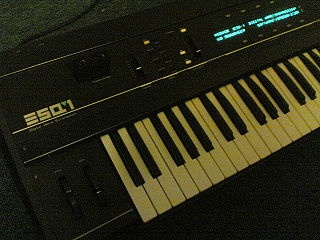
Ensoniq ESQ-1 is a 61-key, velocity sensitive, eight-note polyphonic and multitimbral synthesizer released by Ensoniq in 1985. It was marketed as a "digital wave synthesizer" but was an early Music Workstation. Although its voice generation is typically subtractive in much the same fashion as most analog synthesizers that preceded it, its oscillators are neither voltage nor "digitally controlled", but true digital oscillators, provided by a custom Ensoniq wavetable chip. The signal path includes analog resonant low-pass filters and an analog amplifier.
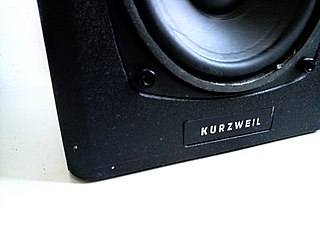
Kurzweil Music Systems is an American company that produces electronic musical instruments. It was founded in 1982 by Stevie Wonder (musician), Ray Kurzweil (innovator) and Bruce Cichowlas.

The Ensoniq MR61 is a 61-key music workstation synthesizer that Ensoniq released in 1996. It features a 16-track sequencer, digital effects, and several hundred onboard sounds or patches.
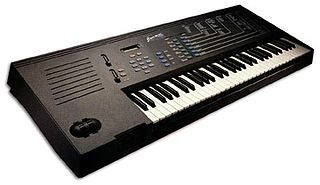
The Emax was a line of samplers, developed, manufactured, and sold by E-mu Systems from 1986 to 1995. Sold alongside their more expensive Emulator II and III samplers, the Emax line was conceived after the release of the Akai S-612 and Sequential Prophet 2000, and was designed to compete for the lower end of the sampling market.

The Ensoniq Performance Sampler (EPS) was one of the first few affordable samplers on the market. It was manufactured from 1988 to 1991 by Ensoniq in Malvern, Pennsylvania, US. The EPS is a 13-bit sampler and replaced the Mirage - widely regarded as the first truly affordable sampling keyboard.

The Akai S3000XL is a sampler with 32 polyphonic voices, and 2 MB of built-in RAM.
The Ensoniq TS-10 was a synthesizer and music workstation introduced by Ensoniq in 1993. It provided synthesis, user sample playback, sequencer, effect units and performance facilities in a 61-key package.

The Ensoniq VFX Synth was initially released as a performance type synthesizer in 1989. It was soon followed by the release of the VFX-SD, which included some updated waveforms, a 24-track sequencer and a floppy drive. Both models were equipped with the Ensoniq Signal Processing (ESP) chip for 24-bit effects. The VFX-SD also included two AUX outs, which allowed for a total of 4 outputs from the synth for more routing flexibility. The initial models were 21-voice polyphony, and in latter models of the VFX-SD (I/II) and the SD-1, the polyphony was 32.

The Korg DSS-1 is a polyphonic sampling synthesizer released by Korg in 1986. As Korg's initial entry into the sampling market, the DSS-1 combines sampling, additive synthesis, and waveform drawing with an analog signal path. The DSS-1 was released a time when major synthesizer manufacturers like Yamaha and Casio were beginning to explore sampling, an area of sound design dominated by companies like Fairlight, E-mu, and Ensoniq. Korg did not stay long in the sampling arena; the DSS-1 was the company's only sampler until 1998 when Korg introduced sampling options on their Triton and Trinity series of workstations.

The Ensoniq SQ-80 is a digital/analog synthesizer manufactured from 1987 to 1989. It was Ensoniq's update to its first synth, the Ensoniq ESQ-1.
The Roland W-30 is a sampling workstation keyboard, released in 1989. It features an on-board 12-bit sampler, sample-based synthesizer, 16-track sequencer and 61-note keyboard.
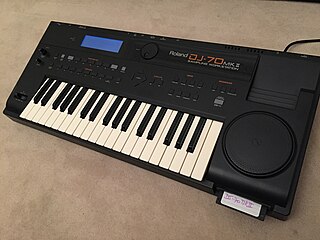
The Roland DJ-70 is a 16-bit linear A/D Conversion & 20-bit linear D/A Conversion sampling workstation and was released in 1992 by Roland Italy.
The Ensoniq EPS-16 Plus is a sampling keyboard produced by Ensoniq starting in 1990. It was the successor to the EPS, one of the first truly affordable samplers on the market. The EPS-16 Plus uses 16-bit samples at seven sample rates ranging from 11.2 kHz to 44.6 kHz and features 13 onboard effects. The unit was available in both keyboard and rackmount versions (EPS-16R). Some versions of the EPS-16 Plus were sold as "Turbo" units, which included an extra 1 MB of flash memory and SCSI upgrades. These units are designated with a "T" after the model number.
















